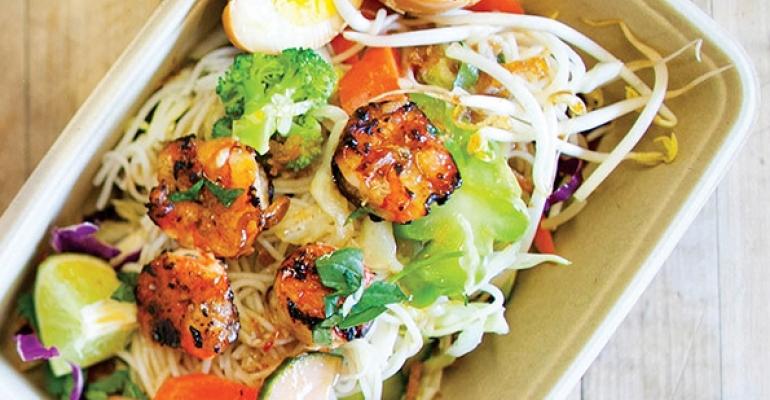Looking back at the year in seafood, one can’t help but be grateful for chefs, the culinary magicians who brought diners their favorite fruits of the sea in creative preparations, menued species many didn’t know even existed or that were so tasty, and worked hard to help diners understand the complex world of seafood sustainability.
Across the country last year, chefs tried to challenge diners to eat more than just shrimp — the most consumed species in the U.S. — either by creating innovative new dishes with the crustacean or by turning diners on to new species altogether.
In October, which is National Seafood Month, many chefs offered fresh takes and ethnic variations on shrimp dishes. Jason Henderson, chef of the fast-casual seafood chain Captain D’s, which serves 5 million pounds of shrimp in its more than 500 restaurants each year, introduced a number of new dishes in its annual Shrimp Feast, including Shrimp Scampi, Shrimp Jambalaya and Shrimp, Cheese and Bacon Bites. In November, at Black Tap Craft Burgers & Beer and Black Tap Meatpacking in New York City, chef and co-owner Joe Isidori added shrimp cakes and shrimp burgers to the menu. The Union Kitchen in Houston, which has three locations, added shrimp meatballs to the menu.
Meanwhile, other chefs sought to introduce lesser-known species, such as wreckfish, triggerfish and grey mullet, in the hopes that one might become diners’ new go-to seafood. At Refinery in Tampa, Fla., chef and co-owner Greg Baker menued wahoo, a tropical fish with a flavor similar to mackerel, while Adam Hegsted of The Wandering Table in Spokane, Wash., turned to sablefish, a mild Pacific Northwest species also known as butterfish or black cod.
Speaking of cod, chefs made it one of the fastest growing fish on menus last year, according to Datassential MenuTrends. Cod appeared on 31 percent more menus than it did five years ago. Among the those menuing cod last year were chef Richard Chamberlain of Chamberlain’s Fish Market Grill and Chamberlain’s Steak and Chop House in Addison, Texas, who offered a version of a Japanese miso-marinated Alaskan cod, and executive chef Michael Perez of Indaco in Charleston, S.C., who offered a baccala dip made of salt cod.
Other chefs turned to cod-like white fish such as pollock, whitefish and haddock. At Greenpoint Fish & Lobster Company in the Brooklyn, N.Y., neighborhood of Greenpoint, chef Adam Geringer-Dunn used Atlantic pollock in place of cod in his Baja Grilled Fish Tacos. David Groll, director of menu development and corporate chef at the Brass Tap in Tampa, Fla., used haddock in place of cod for his traditional fried fish tacos.
Seafood sustainability continued to be top of mind for chefs and diners alike in 2015. Specifically, the debate over the sustainability of wild versus farmed raged on, and chefs and advocates continued to try to help diners better understand which they should eat.
Industry leader Michael Leviton, chef–owner of Lumière in Newton, Mass., was among the many chefs who continued to be outspoken about sustainable seafood and to offer sustainable seafood options, along with source notes and other information for concerned diners.
Andrea Reusing, chef–owner of Lantern in downtown Chapel Hill, N.C., made a strong case for supporting local, sustainable seafood — and often unfamiliar but flavorful species — with the opening of The Durham, her local, coastal-seafood-centric restaurant and rooftop bar inside The Durham Hotel in Durham, N.C.
Others continued to educate and advocate the industry and diners about seafood sustainability, including Barton Seaver, chef and author of For Cod & Country, and Sheila Bowman, manager of culinary and strategic initiatives for the Monterey Bay Aquarium Seafood Watch program.
While there were diverse opinions about what seafood to eat in 2015, all were likely pleased with the announcement that the U.S. Department of Agriculture 2015 Dietary Guidelines are expected to recommend that consumers eat more of it — in fact to double their intake of seafood to two servings per week.





